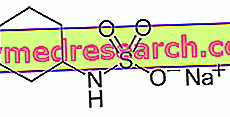Characteristics and use as a sweetener
Sodium cyclamate was first synthesized in 1937 by a doctoral student at the University of Illinois, Michael Sveda, who accidentally discovered his sweet taste. The patent for the production of sodium cyclamate became the property of the Abbott laboratories, which carried out the necessary studies to be able to use it as a safe sweetener. In the 1960s, consumption of cyclamate in the United States skyrocketed, as it became popular to soften "soft drinks" mixed with saccharin. However, the aspect related to its toxicity is still widely discussed and some countries, including the USA itself, have banned the use of food.

The cyclamates derive from the sodium and calcium salts of cyclamic acid. Cyclamic acid, or cyclohexylsulfamic, is a white crystalline powder, with a melting point (169-170 ° C), good solubility (1g / 7.5ml) and a sweet-sour taste. It's a strong acid. The pH of a 10% solution is about 0.8-1.6. The sodium salts (sodium cyclamate) and calcium (calcium cyclamate) derivatives, are powerful electrolytes, therefore in solution they are highly ionized. Both salts exist as crystals or white crystalline powders. They are very soluble in water (1g / 4-5 ml), but not in oils and apolar solvents. Cyclamates are stable to light, heat and a wide pH range.
Cyclohexylamine is the compound from which cyclamic acid and its salts are derived; it is also the product of their metabolism and has completely distinct properties, some toxic (see below).
Cyclamate, unlike saccharose (immediate sweet, intense, clean taste), has a sweet taste that is delayed but very persistent; it is considered about 30 times sweeter than sucrose, but its relative sweetening power tends to decrease with increasing concentration. This characteristic can be partly explained by the aftertaste and bitter taste perceived at high concentrations. Calcium salts are considered less sweet than those of sodium, besides the problems of aftertaste and unpleasant taste (off-taste) are already felt at lower concentrations than sodium salt and acid.
The main use of cyclamate is as a non-caloric sweetener, generally in association with other sweeteners, but it can also be used as a flavoring agent (to mask the taste of drugs). In countries where its use is permitted, it is used as a powdered sweetener or tablets or in liquid form, in beverages and fruit juices, in fruit-based products, in chewing gum and candies (it is acariogenic), in coding, jellies jams and toppings.
The use of sodium cyclamate is allowed in 50 countries, including Italy, although with some limitations. ADI varies from country to country and is around 0-11 mg / kg of body weight. The weight in mg is related to cyclamic acid.
Cyclamate is usually used in a mixture with other sweeteners and in particular with saccharin. In this mixture the off-taste is non-existent and the sweetening power is considerably enhanced: at least 10-20% of synergistic effect was observed when saccharin and sodium cyclamate are used together. For example, 5 mg of saccharin and 50 mg of cyclamate mixed together are as sweet as 125 mg of cyclamate alone or 12.5 mg of saccharin alone. Usually, the ratio used in these cyclamate / saccharin mixtures is 10: 1 because with this combination each component contributes equally to the sweetening power (as the saccharin is about 10 times sweeter than the cyclamate). Some more recent applications see sodium cyclamate together with aspartame or acesulfame K or in ternary combination with saccharin and aspartame.
Sodium cyclamate has a number of technical qualities that make it suitable for use as an alternative sweetener. It is not caloric and is not cariogenic. Although its sweetening power is lower than saccharin and aspartame, it is suitable for use as a sweetener, especially in combination with other sweeteners. At normal concentrations the taste profile is favorable and enhances fruit aromas; it is compatible with many foods, ingredients, natural and artificial flavors, other sweeteners, chemical preservatives. The solubility in water is excellent, also the stability at high and low temperatures, at various pH and in the presence of light and oxygen. It is not hygroscopic and does not support the growth of fungi and bacteria.
Safety of use and side effects
Sodium cyclamate is slowly and incompletely absorbed along the gastrointestinal tract. In a study involving about 200 subjects, cyclamate absorption averaged 37%. Once absorbed, the sodium cyclamate does not concentrate in the tissues and is excreted in the non-metabolized urine; additional studies have shown that in some people, including humans, sodium cyclamate can be metabolised to cyclohexylamine, although in very variable percentages from subject to subject, in the same individual at different times, in various countries around the world, etc.
Sodium cyclamate is not metabolized by tissues, but cyclohexylamine is formed by effect of microflora on sodium cyclamate not absorbed along the intestinal tract. Cyclamate has long been studied for its presumed carcinogenicity against the bladder of rats. The problem is similar to that of saccharin and in fact the studies were conducted mainly in relation to the association of the two sweeteners. There are still many issues regarding its toxicity, but no real direct evidence. In the USA the use of sodium cyclamate is still prohibited. The cyclohexylamine metabolite is considerably more toxic and it is precisely this toxicity that limits the use of cyclamate as a sweetener; many studies are still in progress, but the two main areas in which problems of toxicity can be seen concern cardiovascular effects and testicular atrophy.



